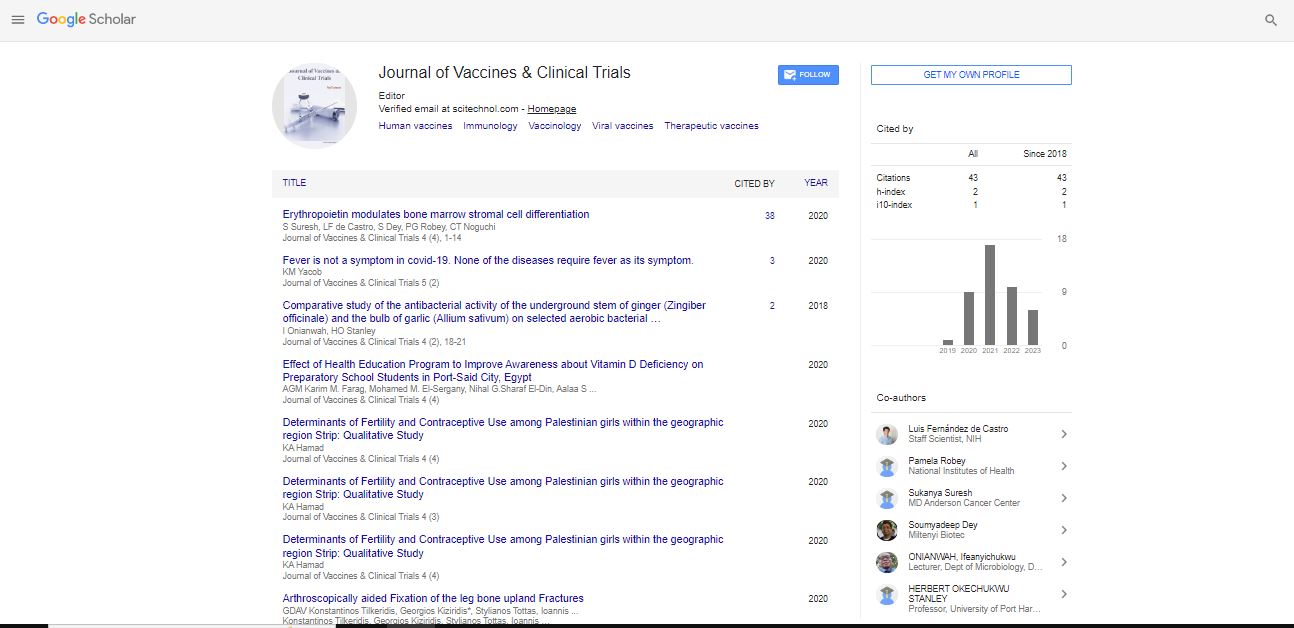Opinion Article, Jou Of Vac Cli Tr Vol: 7 Issue: 3
The Present and Prospective Paths of Medical Antiviral Therapy
Harrell Pawlik*
1Department of Infection Disease and Clinical Microbiology, Siirt State University, Siirt, Turkey
*Corresponding Author: Harrell Pawlik,
Department of Infection Disease andClinical
Microbiology, Siirt State University, Siirt, Turkey
E-mail: harrepaw@gmail.com
Received date: 28 August, 2023, Manuscript No. JVCT-23-118128;
Editor assigned date: 31 August, 2023, PreQC No. JVCT-23-118128 (PQ);
Reviewed date: 14 September, 2023, QC No. JVCT-23-118128;
Revised date: 21 September, 2023, Manuscript No. JVCT-23-118128 (R);
Published date: 28 September, 2023, DOI: 10.4172/JVCT.100083
Citation: Pawlik H (2023) The Present and Prospective Paths of Medical Antiviral Therapy. Jou of Vac Cli Tr 7:3.
Description
Antiviral therapy has long been an essential part of modern medicine's arsenal in the battle against infectious diseases. Over the years, it has evolved from basic treatments to sophisticated, targeted approaches that tackle viral infections at their core.
Medical antiviral therapy encompasses a wide range of treatments that aim to suppress or eliminate viruses within the human body. These therapies have had a profound impact on healthcare, improving patient outcomes and mitigating the spread of viral diseases.
The introduction of Antiretroviral Therapy (ART) marked a turning point in the management of Human Immunodeficiency Virus and Acquired Immune Deficiency Syndrome (HIV/AIDS). ART consists of a combination of drugs that effectively suppress the replication of the HIV. This has transformed HIV from a deadly disease into a chronic, manageable condition, significantly extending the lifespans and improving the quality of life for those living with the virus.
The development of Direct-Acting Antivirals (DAAs) has revolutionized the treatment of hepatitis C. These drugs target specific steps in the Hepatitis C Virus (HCV) life cycle, effectively curing the infection in most cases. DAAs are not only highly effective but also have fewer side effects compared to older therapies, making hepatitis C elimination a realistic goal.
Influenza, or the flu, remains a significant global health concern. Antiviral drugs like oseltamivir and zanamivir can reduce the severity and duration of flu symptoms if administered early. However, the efficacy of these drugs can be limited due to the rapid mutation rate of the influenza virus.
The ongoing COVID-19 pandemic has prompted a rapid search for effective antiviral treatments. While vaccines have been instrumental in disease control, antiviral drugs like remdesivir and molnupiravir have been developed and authorized for use to reduce the severity and duration of illness in COVID-19 patients.
Efforts are in progress to develop antiviral drugs that can target a wide range of viruses. These broad-spectrum antivirals would provide a rapid response to emerging infectious diseases and potentially address known viruses that lack specific treatments.
Analysts are focusing on identifying vulnerable points in the viral life cycle, particularly viral entry and replication. By understanding the key processes, they aim to design drugs that inhibit these stages, preventing the virus from establishing infection.
Combining the principles of vaccination and antiviral therapy bears potential. For instance, therapeutic vaccines aim to stimulate the immune system to target specific viral infections, potentially offering curative effects. This approach could be particularly relevant in treating chronic viral diseases like HIV.
Ribonucleic Acid interference (RNAi) is a novel approach that involves using small RNA molecules to "silence" the genes responsible for viral replication. RNAi therapy has shown potential in targeting a wide range of viruses, including hepatitis B and respiratory viruses.
In addition to drug development, advances in drug delivery methods are enhancing the effectiveness of antiviral therapy. Nanoparticlebased drug delivery systems and targeted drug delivery to viral reservoirs are areas of active analysis.
Personalized medicine, driven by genomic and proteomic data, is likely to play a significant role in the future of antiviral therapy. Customizing the treatments to individual genetic and immune profiles can maximize efficacy and minimize side effects.
While the prospects for the future of antiviral treatment are encouraging, several challenges must be addressed. These include the emergence of drug resistance, the need for equitable access to antiviral treatments and the high cost of drug development and healthcare delivery. Additionally, the rapid mutation rates of certain viruses can pose obstacles to long-term treatment success.
Conclusion
Medical antiviral therapy has made great progress, transforming the landscape of infectious disease treatment. From the success of ART in managing HIV/AIDS to the revolutionary DAAs for hepatitis C, the present state of antiviral therapy is marked by remarkable achievements. The COVID-19 pandemic has accelerated the analysis and development in the field, leading to new treatments and inputs.
 Spanish
Spanish  Chinese
Chinese  Russian
Russian  German
German  French
French  Japanese
Japanese  Portuguese
Portuguese  Hindi
Hindi 